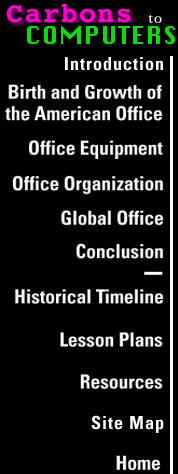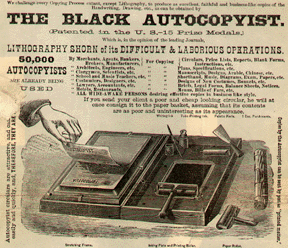
Copiers
Today copiers are everywhere, making more copies than anyone needs. In the late 1980s, Xerox corporation copied more than 20 million pages in one year, just to see if its machines worked.

The first method for making a typed copy was carbon paper. Used for little more than credit card receipts today, carbons were once the bane of typists. Messy and unforgiving of mistakes, carbon paper enabled the typist to make a somewhat smeary duplicate of what he or she was typing.
 The mimeograph machine of the 1890s, still in use today, particularly
in schools, increased the number of copies that could be made from a few
to a hundred, using what was known as a "master." But the only
way to copy an original after it had been made was to retype, redraw, or
rephotograph it.
The mimeograph machine of the 1890s, still in use today, particularly
in schools, increased the number of copies that could be made from a few
to a hundred, using what was known as a "master." But the only
way to copy an original after it had been made was to retype, redraw, or
rephotograph it.
The photostat machine was developed before World War I, but it was hardly an office tool. It was too expensive, too big, and, requiring a trained operator, too difficult to use.

After World War II, 3M and Eastman Kodak introduced the Thermo-Fax and verifax copiers into the workplace. The copies were of poor quality and continued to darken long after they had been pulled from the machine. Although the office models were relatively inexpensive and easy to use, their special paper eventually cost users a fortune.

Chester Carlton's discovery of the effect of light in photoconductivity, however, led to the unprecedented success of the "Xerox" machine. The first commercial Xerox machine, the Haloid Xerox 914 of 1960, had defects, such as paper scorching. Nevertheless, today's copiers produce near-perfect images, in color as well, in record time.